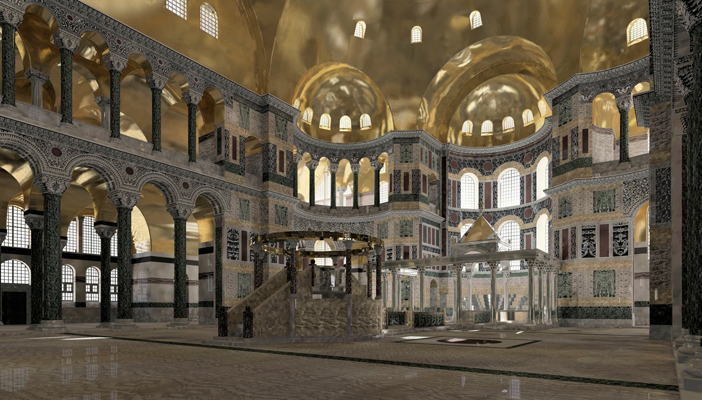
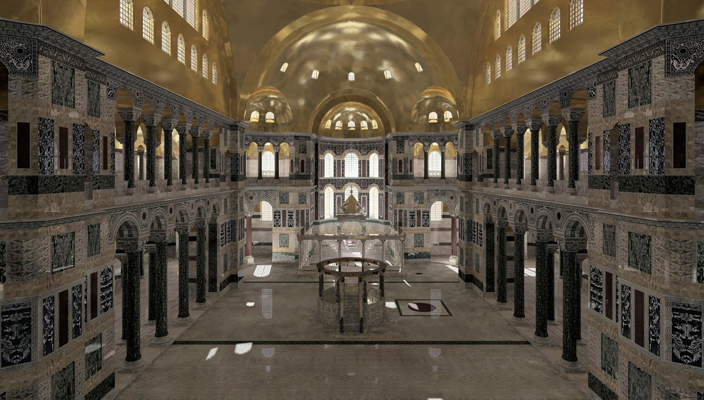
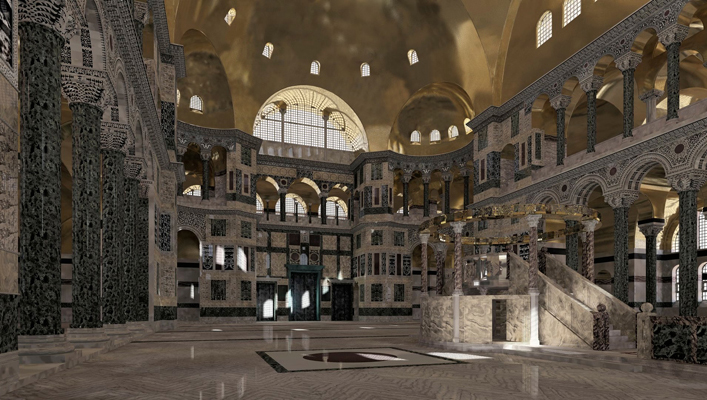
Above are three reconstructions of the interior of Hagia Sophia showing the sanctuary fittings, These are really great. They were presented at a conference in 2007 and updated this past September 2018. They were created by Technische Universität Darmstadt, Lucerne University of Applied Sciences and Arts - Andreas Noback, Lars O Grobe and Franziska Lang - to show the effect of different types of lighting in Hagia Sophia. Thank you, Andreas, Lars and Franziska! These also show what the vaults would look like - and how they reflect light - with the plain gold mosaic. These give us a great idea of what the sanctuary of Hagia Sophia looked like before 1453. All of this was lost forever when Mehmet II mounted the altar to pray and thus convert the church to a mosque. Very soon after the conquest the sanctuary was totally cleared out, the sanctuary floor was reoriented to Mecca and a Muslim mithrab was added to the back wall of Hagia Sophia.
The central focus and the chief reason for the existence of church of Hagia Sophia was the celebration of the liturgy. Every service began with a procession. The floor of Hagia Sophia was like a great sea, it was paved with light gray Proconnesian marble that was banded in light blue veins. These 6 ft long marble panels were set in the floor to show of their wave like veining. Although significant parts of the marble floor were damaged and repaired each time the dome or parts of the vaults fell, a very large part of the original (after Justinian's second dome in 558). After the collapse of the second dome a second marble floor was laid over the top of the original one.
This marble floor has four bands in Verde Antique (antico) marble that marked various stages as processions moved towards the sanctuary. They were called rivers - depicting the four rivers of paradise - and the bands are around 2 ft wide. They are no longer complete, surviving in varying degrees. The first one is 55 ft from the door, the second one is 30 ft beyond that, the third river is 29 ft further. The last one surrounded the chancel screen and area of the sanctuary, and only 20% of it survives. These bands are not symmetrically positioned, which means they were not just decorative. The most plausible explanation is that - from the outset they were intended to mark out stages in processions that moved through the church to the sanctuary.
Hagia Sophia was always a church of great processions. Its vastness made these much longer than other churches and they could involve thousands of people carrying various things like icons, crosses, chalices, flabellum, relics, swaying incense burners and candles. There would be choristers, clergy, Imperial officials, the Emperor and common worshipers in them. These processions were difficult to orchestrate as they moved across the nave. The rivers helped you find your place. Various liturgical acts also were performed along the way that were organized around the rivers.
As an example during certain solemn vespers services the Patriarch would enter the nave through the Royal Doors and as he arrived at the first river he would turn and venerate the great, life-sized, mosaic icon of a standing Christ of the Chalke Gate which was set high above the western door, before proceeding to his throne in the apse. All of these rivers were stage-markers for the great processions of which Hagia Sophia was so famous.
Below is my reconstruction of the chancel screen in Hagia Sophia:
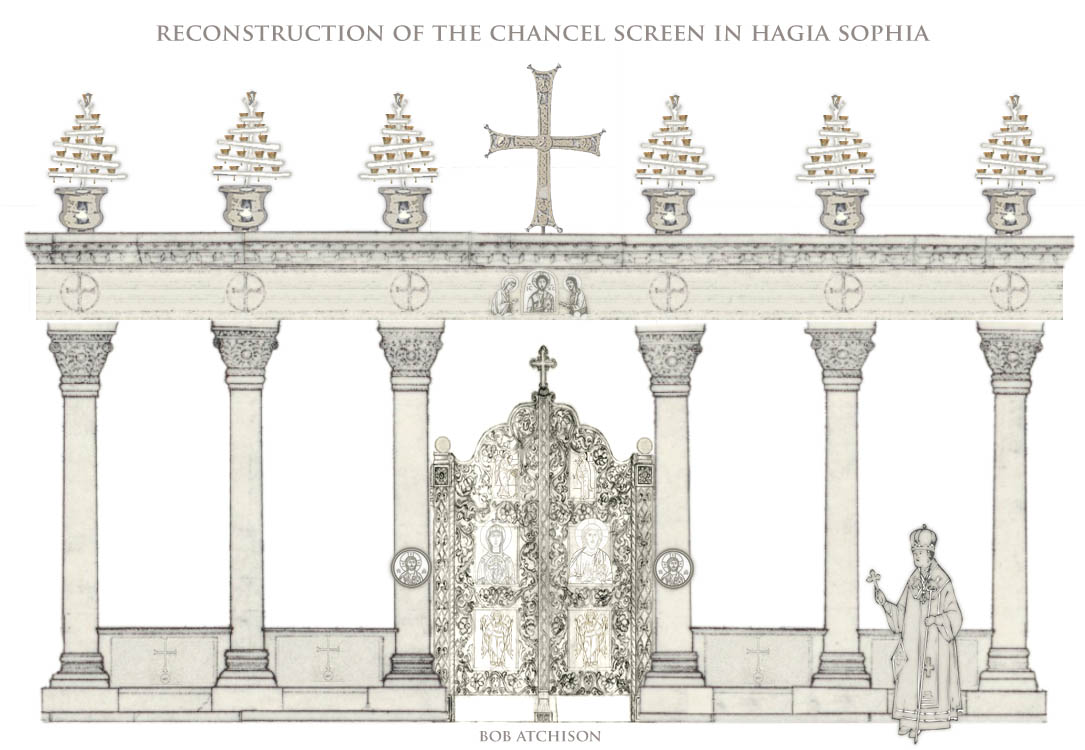
The fourth and last river shows repairs from the fourteenth century collapse of the great eastern arch and part of the dome. It marked off the area of the eastern end of the church which was reserved for the clergy. It also encompassed the great ambo, solea and chancel screen of the church. Choristers also stood around the ambo here and chanted psalms and the liturgy. Below is a picture, taken by Ken Grubb, of people lying on the floor of Hagia Sophia next to one of the rivers:
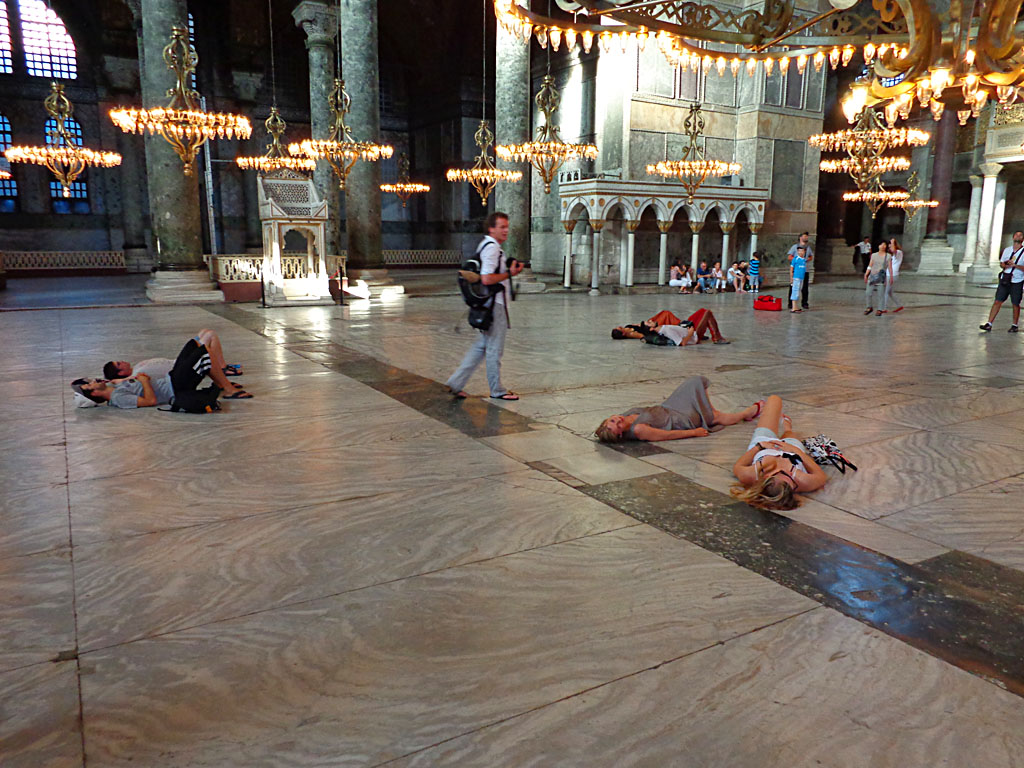
Within this demarcation one large 6.5 ft fragment of the stylobate - the base of the chancel screen - in green porphyry from Sparta was found in 1955. It is from the left side and is near the Sultan's Box, and has three dowel holes in it. Below is a diagram of the floor drawn by Robert Van Nice, showing every floor slab:
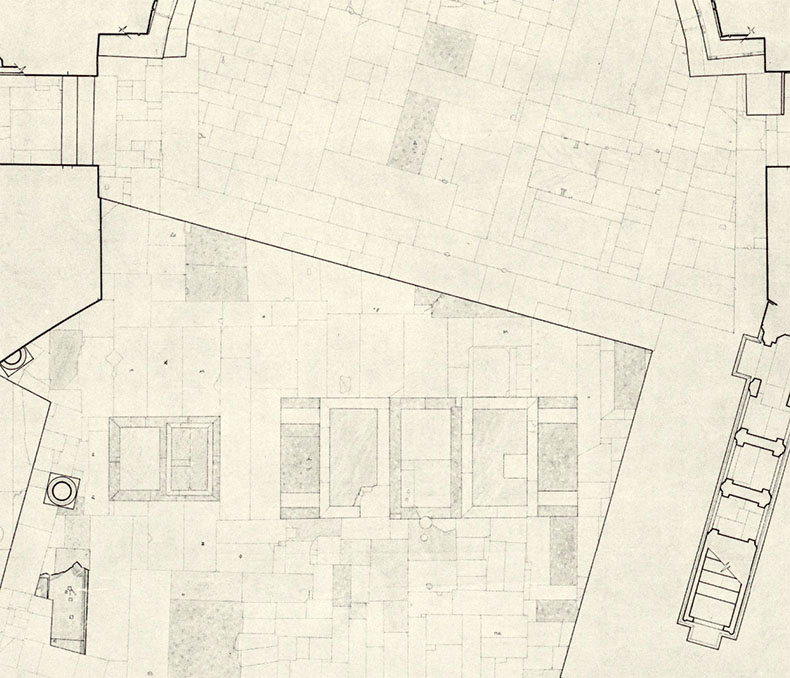

Above is a left (north) side reconstruction of the chancel screen, solea and ambo in Hagia Sophia by Stephen Xydis.
The chancel screen of Hagia Sophia, which separated the sanctuary from the nave was 51 ft wide and its long west side and round 30 ft long on the sides. There were 12 columns, six on the front and three on each side. The columns were 16 feet tall including their shafts, cases and capitals. This is the same size as the same Verde Antique columns facing the nave in the galleries. The capitals are in white Proconnesian marble. One can assume that they would have been the same marbles in the chancel screen.
The width of the central bay in the western front was wider than the rest of the them. We can determine the location of the central bay from a large inset rectangle in the floor which is directly on the north-south axis. The rectangle in banded in red porphyry and has two nicely matched slabs of wavy Proconnesian marble within it The red porphyry band on the north side is 8 ft wide. The openings between the columns would have been around 9 ft, with the central one larger. On the top of the colonnade was an architrave that was wide enough to accommodate a walkway for lamplighters to attend to the great silver tree candelabra that were set here.
There was a two step rise in the chancel screen, further in the apse where was one additional step. This floor still exists to a great extent. The Turks later carved it up to make it align with Mecca. There are many splendid colored marble panels laid into the floor marking the north-south path within the chancel screen. This path is in two different lengths - the northern end of the same width as the central bay in the colonnade here. This marble path also indicates the location of the great altar and ciborium.
As mentioned earlier there were 12 tall silver trees set with hanging glass lamps. The people who attended them are called "fire-bearing wayfarers" by Paul the Silentary. These were described by Paul the Silentary as "pine trees" and they had five tiers with around 30 glass lamps set in medal circles. They stood in huge silver bowls and had silver crosses between them. There were also lamps which hung in front of the icons on the chancel screen from silver brackets. More light was provided by lamps hung from eight big iron brackets that extended from the gallery level cornice. They are around 6-12 feet long and have curled hooks on their ends to keep lamps from slipping off. They were set on two different levels. Two were attached to the top cornice furthest east. These could have illuminated the mosaics in the apse. There are also five marks in the marble blocks of the top cornice of the apse were lights could have been placed. There are also six big round iron hooks in the top cornice, I am not sure what the were used for, perhaps they could have held chains of some kind that stretched across the apse. Four more bar-brackets extended into the space of sanctuary arch and were hung from the cornice at gallery level. These could have illuminated the back of the altar area and especially the passages at ground level. Two more bars extended from the corners at the beginning of the exhedra at gallery level. The bars at the corners of the exhedra are shorter and were placed parallel to the sides of the chancel screen, They would have illuminated the side entrances of the screen. Each bar could have easily held three hanging multiple light chandeliers. It is also possible that other things, like crosses and votive crowns could have hung from them. There might have also been five or more standing chandeliers attached to the cornice under the apse mosaics. On top of this there are around 50 single hooks embedded in the two marble cornices for individual lamps or chandeliers. All of this lighting - probably more than 2,000 lamps - would have provided a great deal of softly glittering illumination to the sanctuary. These many points of light would not have cast shadows like modern lighting and the gold glass mosaic would have reflected the light back from millions of tiny mirrors.
Below is a plan of the eastern end of Hagia Sophia showing the location of the chancel screen, solea and ambo:
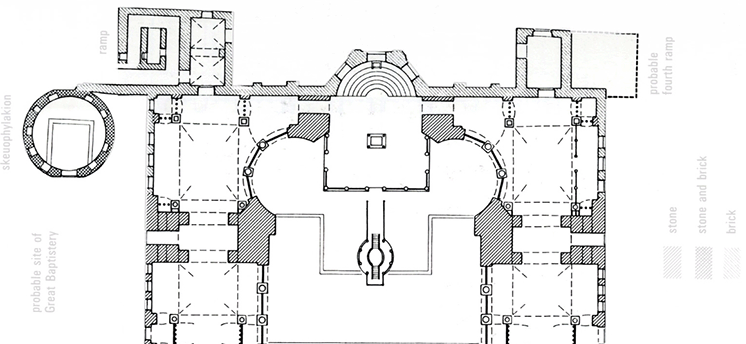
The architrave was decorated with images of Christ, the Theotokos, Saints and Angels. We can image more icons hanging here is silver and gold. The central bay may have had a Deesis above it. It seems that there was a great silver bracket with arms that went across the front of the architrave where icons were hung from. There were also icons hung on the columns. They were kept at a level so people could venerate and kiss them. There were great wooden doors that were plated in silver that closed off the central bay. They were covered in icons as well. There was also a great jeweled cross above the central door mounted on top of the architrave. After 1204 the sanctuary furnishings were recreated after the reconquest of the city by Emperor Michael VIII Palaiologos in 1261. One can imagine the huge expense involved in replacing this and all of the silver chandeliers in the church. All of this was then destroyed in the collapse of the great eastern arch and segment of the dome in 1348, when the chancel screen was smashed and all of the icons in it were destroyed. Once again the broken silver parts were melted down and recreated.
Unlike the modern day iconostasis icons were not hung between the columns of the chancel screen, which remained open. Perhaps this changed in the last years of the empire when more icons could have been added. The arches in the chancel screen had lined silk curtains. They were woven in thick six thread samite twill with beautiful patterns and images of Christ, the Theotokos and Saints. The were woven in long horizontal strips and sewn together into panels. These strips could be in contrasting colors. They had silk fringe on the bottom and were double-sided. The view from within the sanctuary was just as important as what you could see from the front. Due to the soot from lamps, the smoke of incense, and constant use, they were very hard to keep clean and maintain. The curtains were not closed all of the time and you could see into the sanctuary ciborium and altar. Below you can see an eleventh century manuscript illumination showing horizontally-banded curtains with tassels and how they were hung between columns:
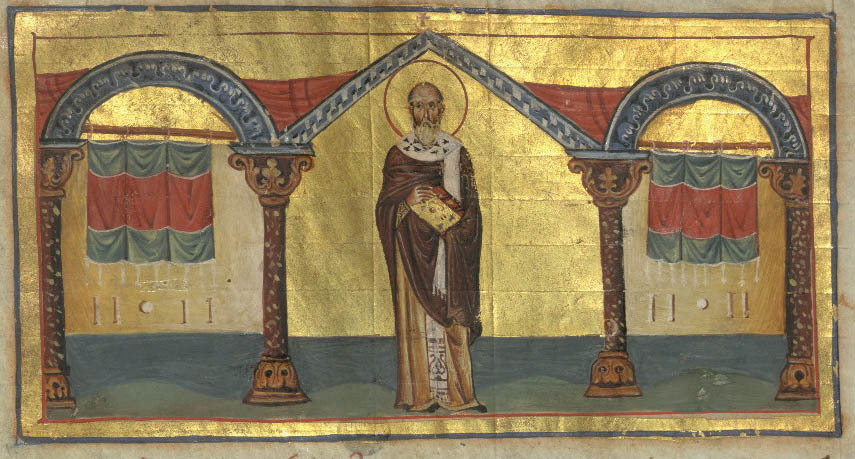
Seeing the altar was very important to pilgrims. The pilgrim path through the church took visitors through the far left doors of the narthex, through the north aisle and then into the sanctuary through the red porphyry columns in the northeast exhedra. The porphyry columns have crosses inset into the tops of they bases for pilgrims to kiss as they entered the nave here. You can still see where they were. Pilgrims would see the sanctuary from the left side of the chancel screen as they entered the nave and went around it. They would have been directed by guides which icons and crosses on the chancel screen could be venerated and kissed by them as they passed by. One can imagine the enormous wear and tear done here by the hundreds of thousands of people who used the church every year.
Between the columns were parapets that were a little over three feet tall with a balustrade along the top - like an altar rail. There were decorated with crosses and monograms.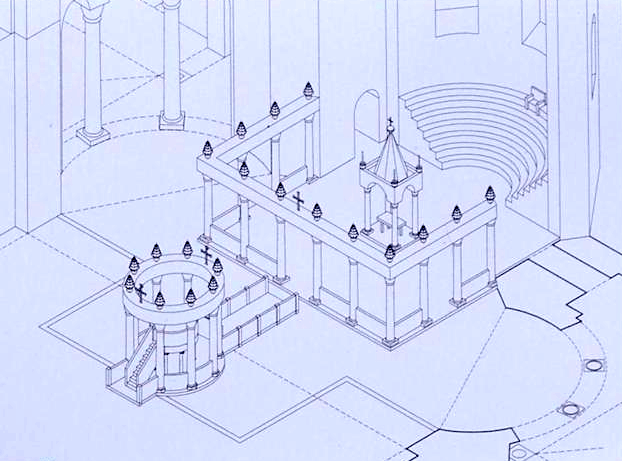
The anonymous author of the Novgorod Chronicle says that the entire chancel screen was made of solid silver that the crusaders in 1204 cut into pieces when they looted the church. This cannot be true. Up until 1204 it seems the chancel screen was made of marble plated in silver, not cast and chased solid silver. Procopius says Justinian used 40,000 lbs of silver here. They also say the ciborium (khiot) of the great altar was solid silver.
However, we know that this is true because Paul the Silentiary, an eyewitness to the building of Hagia Sophia, tells us:
"Not only upon the walls which separate the priest from the choir of singers has he set plates of naked silver, but the columns, too, six sets of twain in number, he has completely covered with the silver metal, and they send forth their rays far and wide"...
"And above the all-pure table of gold rises into the ample air an indescribable tower, reared on fourfold arches of silver. It is borne aloft on silver columns on whose tops each of the four arches has planted its silver feet. And above the arches springs up a figure like a cone, yet it is not exactly a cone: for at the bottom its rim does not turn round in a circle, but has an eight-sided base, and from a broad plan it gradually creeps up to a sharp point, stretching out as it does so eight sides of silver."
There was also a great deal of silver-gilt in the sanctuary and well as huge amounts of gold and precious gems. All of this silver was less expensive than one might imagine. Justinian had to replace it entirely when the first dome collapsed, although the base silver was melted down and recast. I estimate the silver (not taking into account the gold and gems) in the sanctuary would have cost $20+ million. The Byzantines were very good at silver-gilt and much of what appeared to be gold was that. Silver-gilt wears off in hundreds of years of polishing and would have had to have been renewed. This wear It can been seen in the silver-gilt Byzantine chalices now in the Treasury of St. Mark's in Venice. It's a dangerous process involving heat and mercury. The enamels are done on thin plates of solid gold.
In late Byzantine times Hagia Sophia had five huge solid gold disks that were very valuable. They may have been hung between the columns across the front of the chancel screen. Some, if not all of them, had to be melted down and converted into coin in the last years of the empire.
In 622 the Emperor Heraclius, in the dark days of Persian attacks on the Empire, was forced to melt down some of the treasures of Hagia Sophia to finance a new army:
"In this year, on April 4, in the tenth indication, immediately after Heraclius had celebrated the festival of Easter, on Monday evening, he moved against the Persian power. He seized the possessions of the blessed houses (churches) in loan, and, impelled by his lack of resources, he even took many candles (gold and silver candle sticks) and other serviceable implements of the Great Church itself, and struck gold coins and very many miliaresia (silver coins)."
The altar was a marble slab set on four columns of gold. Robert of Clari says it was 14 ft long.
The altar was a place of sanctuary, if you were touching it you could not be removed by force. Fugitives are reported grabbing onto the edge of the altar slab and clinging to it for dear life. Patriarchs took this promise of sanctuary very seriously. One who was in his palace heard a fugitive was about to be removed from the altar by policemen, crossed into the church, came down the stairway into the nave and then embraced the fugitive. Giving him his personal protection. When the fugitive had to eat or use the privy the patriarch would return to escort him.
The altar was hung with dozens of silver and solid gold lamps and set with candelabra. A jeweled votive crown of Constantine I was hung from the canopy along with a great golden dove symbolizing the Holy Spirit. Votive crowns donated by other emperors hung nearby the ciborium. Anthony of Novgorod, who visited Hagia Sophia in 1200 describes them:
"The crown of Constantine, decorated with pearls and precious stones, hangs in the center under the ciborium over the holy table in the main chancel. A cross hangs from it with a golden dove under the cross and the crowns of the other emperors are also hung around the ciborium. The ciborium is all of silver, decorated with gold, and the altar columns and ambo are [also] of silver. The thirty small crowns hung around the ciborium are to remind all Christians of the thirty pieces of silver for which Judas betrayed the Lord God Christ.
"In front of this big cross hangs a gold cross one and a half cubits high, with a golden lamp in which oil bums hanging from each of the three arms (and it is all hung from above by the fourth arm). The emperor Justinian the Great, who built St. Sophia, erected these lamps and the cross. These three lamps and the cross were raised by the Holy Spirit above the great tall cross and lowered again gently without [the lamps] being extinguished. This ascension occurred during matins, before the beginning of the liturgy, and everyone in the sanctuary and in the church saw it and said, with awe and great joy... God revealed this holy and venerable wonder in my lifetime, during matins on Sunday, the twenty-first day of the month of May, the feast of the holy emperor".
There was a famous great Bible on the altar that was covered with gold, enamels and gems. The altar also had dozens of hand-held and hanging crosses made of precious metals decorating it. When the crusaders broke open the altar the Novgorod Chronicle reports they found forty barrels of gold inside it. This is, of course, a wild fable, because the altar was open all around.
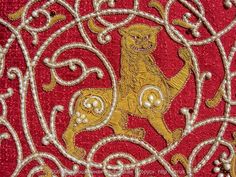 The altar was covered by a great thick silk cloth that was heavily embroidered in silk, gold and silver thread. The cover was sewn with jewels, pearls and golden enamels. The cover folded down over all four sides of the altar and was fastened along its edges. Many people might have assumed this cover was made of gold. During services this was covered in a while veil. On the left is an example of a Russian silk sewn with pearls to show the richness of this kind of work. All of this was lost in 1204, restored in some form after 1261 and finally destroyed and looted forever in 1453. Add to this all of the silver polycandelon hanging from the vaults and dome of the church.
The altar was covered by a great thick silk cloth that was heavily embroidered in silk, gold and silver thread. The cover was sewn with jewels, pearls and golden enamels. The cover folded down over all four sides of the altar and was fastened along its edges. Many people might have assumed this cover was made of gold. During services this was covered in a while veil. On the left is an example of a Russian silk sewn with pearls to show the richness of this kind of work. All of this was lost in 1204, restored in some form after 1261 and finally destroyed and looted forever in 1453. Add to this all of the silver polycandelon hanging from the vaults and dome of the church.
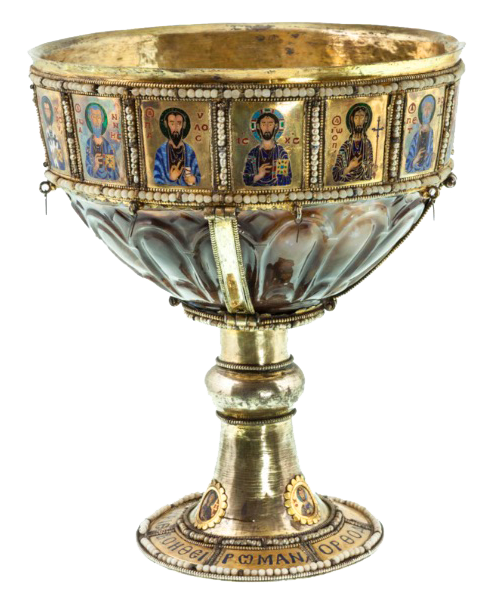 The altar of Hagia Sophia was considered by some to be the most beautiful ornament and the primary treasure of the church. It was covered by a silver, four columned, ciborium with a lofty vault. At top of the ciborium was a golden orb surmounted by a jeweled cross. The anonymous chronicle of Novgorod says the altar had 40 precious chalices on it that were looted by the crusaders. You can see one on the right. All of these chalices originally had covers. At least one of the looted chalices in St. Mark's still has its cover. (We know that emperors brought these chalices to Hagia Sophia one-by-one in procession. Walking behind him, a retainer carried the chalice and top for the emperor, and would hand the cup to him which the emperor then placed on the altar. Next they did the same with the top. Every chalice was honored in the same way). There was a little step for the emperor to stand on at the altar.
The altar of Hagia Sophia was considered by some to be the most beautiful ornament and the primary treasure of the church. It was covered by a silver, four columned, ciborium with a lofty vault. At top of the ciborium was a golden orb surmounted by a jeweled cross. The anonymous chronicle of Novgorod says the altar had 40 precious chalices on it that were looted by the crusaders. You can see one on the right. All of these chalices originally had covers. At least one of the looted chalices in St. Mark's still has its cover. (We know that emperors brought these chalices to Hagia Sophia one-by-one in procession. Walking behind him, a retainer carried the chalice and top for the emperor, and would hand the cup to him which the emperor then placed on the altar. Next they did the same with the top. Every chalice was honored in the same way). There was a little step for the emperor to stand on at the altar.
The historian Niketas Choniates, who witnessed the events of 1204, says that the crusaders used the chalices and altar patens as bread dishes and wine goblets. Choniates comments on the artistic beauty and historical value of all of these things, which he values more than their monetary worth. He reported that mules were brought into Hagia Sophia to help carry off the loot, who slipped and fell on the marble floor while defecating on it. A prostitute mounted the ambo and sang and danced while hurling blasphemies against Christ! What horrors...
Robert of Clari, one of the noble Catholic Christian crusaders who participated in the looting of Hagia Sophia wrote:
"Now will I tell you of the Cathedral of Saint Sophia, how it was built (Saint Sophia, in Greek, signifieth Holy Trinity in our own tongue). The Cathedral of Saint Sophia was altogether round. And there were on the inside of the church, all round about, arches which were borne up by great pillars – very rich pillars, for there was not a pillar that was not either of jasper, or of porphyry, or of other rich and precious stones,... Nor was there any door of this minster, or hinge, or socket, or other furnishing such as is wont to be made of iron, that was not all of silver. And the high altar of this minster was so rich that the price thereof could not be reckoned; for the table which lay upon the altar was of gold, and of precious stones all squared and ground, and all fast joined together; which a certain rich emperor caused to be made. And this table was full fourteen feet in length; and about the altar were pillars of silver, which upheld a canopy above the altar, made like to a bell-tower, and all of massive silver. And so rich was it that one could not reckon the price that it was worth."
"And the place where the Gospel was read was so rich and so magnificent that we could not describe to you how it was made. Then, around the church hung full an hundred chandeliers, nor was there a chandelier that hung not by a great chain of silver, as thick as a man’s arm; and in each chandelier were some five and twenty lamps, or more; nor was there a chandelier that was not worth full two hundred silver marks."
All the loot was ordered turned over and gathered together for division among the thieves:
"Thereafter, a command went forth that all the substance of the body be brought to a certain abbey which was within the city. Thither was the substance brought, and they chose ten noble knights from amongst the pilgrims, and ten Venetians who were reputed to be honorable men, and set them to guard this substance. And when the booty was brought thither, which was so rich and contained such wealth of gold and of silver and of cloth of gold, and so many rich jewels, that it was a fair marvel to behold the great riches that had been brought thither – then, never since the world was established was so great wealth, or so noble, or so magnificent, either seen or won – no, not in the days of Alexander, or of Charles the Great, or before, or after. Nor do I believe, of my own knowledge that in the fifty richest cities of the world could there be so much wealth as was found in the body of Constantinople. For the Greeks also bore witness that two-thirds of all the wealth of the world was in Constantinople, and that the other third was scattered throughout the world."
"But those selfsame ones who ought to have guarded this wealth took the jewels of gold and whatsoever else they desired, and robbed the spoil. And of the rich men did every one take either jewels of gold, or silken cloth of gold, or whatsoever liked him best, and carried them away. In this wise did they begin to steal the treasure, so that no division thereof was ever made amongst the commonalty of the host, nor amongst the poor knights, nor amongst the men at arms, who had all helped to win it – save only of the coarser silver, such as silver ewers that the ladies of the city carried to the baths. But all the rest of the treasure which remained to divide was carried away in such base fashion as I have told you; nevertheless, the Venetians had their half thereof. So the precious stones, and all the greater treasure which remained to divide, went such base ways as we shall presently describe to you."
The altar was hung with dozens of silver and solid gold lamps and set with candelabra. It was covered with precious stones. There was a famous great Bible on the altar that was covered with gold, enamels and gems. The altar also had dozens of hand-held and hanging crosses made of precious metals decorating it. Nicetas Choniates tells us that the ciborium was made of the purest silver, thickly overlaid with gold that weighed "many tens of thousands of pounds".
Somewhere in the sanctuary there was a large silver basin, called a Lenos, for the mixing of eucharistic wine that was decorated with a vine motif.
After the emperor received communion in Hagia Sophia he had breakfast with guests in the red robing chamber in the south aisle. There was also a portable Imperial altar that could be brought to the emperor when he stood at the chancel screen.
Until 1204 on Easter the golden curtains of the ciborium, along with the altar cloth, jeweled crosses and candelabra from the sanctuary were brought up to the West Gallery and put on display for the public to see. Imperial crowns and other gold regalia were added to the display,
Note on the sanctuary during Latin rule and the restoration of Constantinople after 1271:
After 1204, and the destruction of the altar by the crusaders, their successors, the so-called Latin emperors of Constantinople had to rummage about looking for marble columns to reconstruct the altar for use in Latin Catholic services. A letter of Pope Innocent III says that the new Latin patriarch Thomas Morosini took marble columns from the church of the Anastasis "for the decoration of the altar of Hagia Sophia". Mary Alice Talbot tells us:
"Pachymeres relates that after the Byzantine recovery of Constantinople in 1261, the emperor Michael "restored to its previous condition the entire church [of Hagia Sophia] which had been altered by the Italians in many aspects. And placing in charge the monk Rouchas ... he rearranged the bema and ambo and solea." Pachymeres' remarks about the need for the Byzantines to rearrange the bema, ambo, and solea suggest that the Latins may have built a choir screen projecting into the nave in order to enlarge the space for the clergy and to accommodate the choir. The erection of such a barrier might have necessitated the use of marble columns, slabs, and the like taken from other churches."
However, the crusaders had destroyed the chancel screen and had wrecked or destroyed the solea and ambo, too. I can't imagine they would have replaced them during their occupation since they had no need for them. Perhaps they were left in their ruinous conditions and Michael had to put all of this back in order. Michael's number one objective as far as Hagia Sophia was concerned was to make the church ready for his coronation. They will have wanted to follow as exactly as possible the coronation rite (you can read about it here). Since a large part of the rite - and the crowning itself - took place at the ambo they would have needed to make any needed repairs to it right away. There was no money for the expensive replacement of the silver ciborium and altar everything would have needed to be done as frugally as possible. The replacement of the chalices, patens, liturgical fans, candelabra, crosses and other things like gospel covers, would have been done in silver gilt, rather than gold. Some of these must have been brought from Nicaea. All of the old Imperial goldsmith workshops were destroyed in 1204 and never came back. Some their skills, like gold enamel work, were lost forever. Indeed we know from the inventory of the treasure of Hagia Sophia in 1396 that there was only one golden vessel in it.
Soon after his coronation Michael agreed to the union of the Orthodox church with Rome, which began a civil war in the church which played itself out in Hagia Sophia, were various factions pro and against union fought for supremacy. Michael's Patriarch, John Bekkos, who had supported union was deposed. Michael was eventually banned from Hagia Sophia as an apostate and was denied a Christian burial. Considering this turmoil and chaos I think the idea that Michael commissioned the Deesis mosaic as a thank offering for his reconquest of the city does not make sense.
Leading directly from the chancel screen was a enclosed walkway called the solea which let a great ambo which was just east of the center of the nave. Between the chancel screen and the being of the solea was an open space that was about 10 ft long. The floor here is set with a cippolino rosso-bordered pair of Proconnesian floor panels which still indicates where this area was. There is no cippolino rosso band on the west side of it, where it would have opened into the solea. You can see these below:
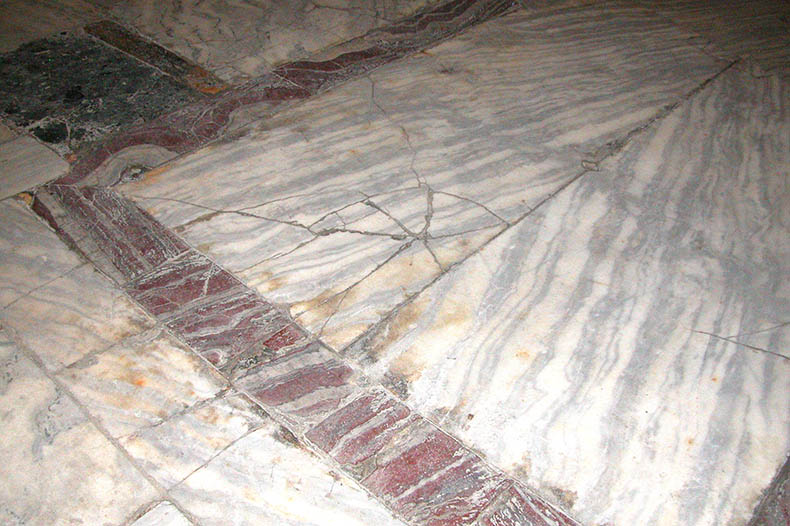
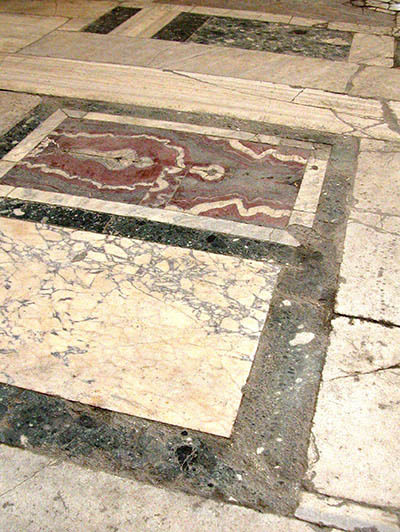
The passageway in the solea was 8ft wide and 52 ft long. The furthest extend of the ambo was 22 ft north of the center of the nave as drawn from the peak of the dome. The ambo was a semi-circular marble platform with two staircases on the eastern and western sides. It had two curved exedra - one on either side - with 8 green Verd Antique marble columns that had inset panels at the bottom. They were three feet tall and served as a railing to separate the congregation from the ambo. These columns were different from those in the chancel screen. They were carved in one piece with tall narrow bases where the panels were slotted in. Here is a picture of what I suspect are the columns from the ambo that are now at Topkapi. The ambo appears to have been raised on columns and had space under the platform where singers were sometimes placed. It had many parts that were plated in silver and silver-gilt, but it was not completely covered like the chancel screen. The ambo had a portable altar that was used in coronations.
In the 12th century there were around 150 singers attached to Hagia Sophia and 25 who were elite psaltai. They sung at the base of the ambo. Sometimes one of the lead singers were ascent the western stairs of the ambo to sing. At the top of the ambo stood the Patriarch when he delivered his blessing to the congregation. Here the deacon recited the Scriptures.
The daily liturgy in Hagia Sophia consisted of matins and vespers which were sung by psalmody, in which the choirs chant the verses and the congregation follows with the refrain. It is a very simple service and everyone participates in it. Over time the service in Hagia Sophia evolved. One of the challenges of the space is the reverberation - or echo - of up to ten seconds. This makes speech in particular had to understand unless you were right next to the ambo, the place were homilies were delivered and the psalms were sung. In response Hagia Sophia choir masters developed a "sung" liturgy that worked much better here. In addition to the sung liturgy around 14 antiphons of psalms were sung around the church in the course of a day. From the Greek for “short utterance," an antiphon was originally a short verse of a Psalm chanted alternatively by two choirs. According to tradition, St. Ignatius of Antioch (ca. 35-110) introduced the chanting of antiphons. In time an antiphon became a short verse chanted between the parts of a Psalm.
The elite choir of Hagia Sophia were the psaltai who chanted for high church events. The sung service in Hagia Sophia was unearthly, it was one of the factors that convinced the Russians to accept Orthodoxy - the service in Hagia Sophia was the closest to heaven a human being could experience at the time. The vocal spiritualism and 'high art' of the service in Hagia Sophia was lost forever in 1453. Click here to listen to some unearthly recreations of Byzantine chant in Hagia Sophia.
The ambo was also the site of liturgical dramas. In 1432, Bertrandon de la Broquiere went one day to Hagia Sophia to observe a service at which the Patriarch officiated on the Sunday before Christmas where he witnessed the performance of "The Three Holy Children and the Furnace". Ignatius of Smolensk, who was in Constantinople earlier in 1389, noted that on this same Sunday before Christmas he saw in Hagia Sophia "how they prepared the furnace of the three holy children." It was performed west of the ambo near to the center of the church. This was a a type of mystery play performed with singers, an organ, costumes and an angel lowered from above. We don't know if the angel was another actor or a dummy dressed as one, or how it was lowered from the dome. The "children" were trained actors in costume. There was a mock furnace that appeared to burn - probably with cloth flames blown with portable bellows. The Byzantines were very skilled with machine driven theatrical devices which had been used for centuries in the Great Place where there will gilt bronze trees with singing birds and lions who roared and waved their tails around. Water organs were used for all kinds of events including performances in the Hippodrome. I don't think the Byzantines had any prejudice against the use of organs in churches, they were always open to new and creative ways of singing in Hagia Sophia. Also the church was the scene of many types of events besides the celebration of liturgy. The Emperor received the chants of singers from the dome and choristers sang secular songs of praise and acclamation to him in the church. The singers of Hagia Sophia were also used for events in public places and palaces. They were employees of the Emperor. You can see a 12th century manuscript illumination of this very event below!
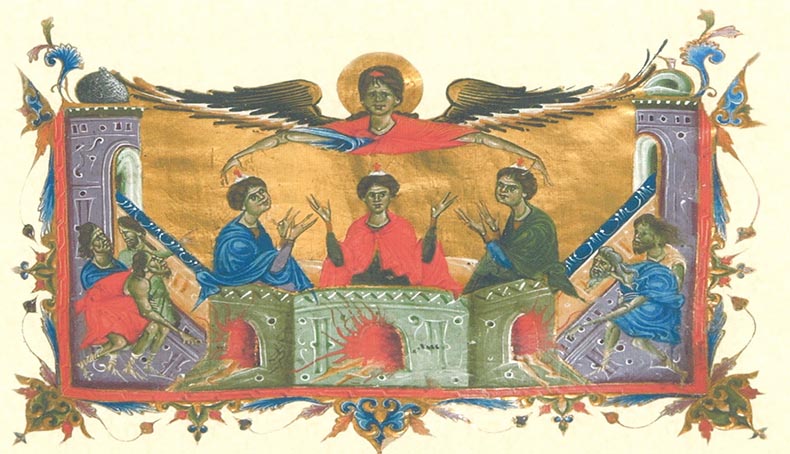
Here is a list of the fixed "feast days" in Hagia Sophia that called for special services and were popular vigils according to the Typicon of the Great Church, during which the faithful would stay in Hagia Sophia all night and listen to various readings from the ambo. The church was kept lit all night. Matins would start right in the ambo in the middle of the congregation.
1 Sept. - Indiction and St. Symeon the Stylite
8 Sept. - Nativity of the Theotokos
14 Sept. - Exaltation of the Holy Cross
18 Dec. - Dedication of the church at Chalkoprateia
23 Dec. - Dedication of Hagia Sophia
25 Dec. - Feast of the Lord's Nativity
6 Jan. - Theophany
2 Feb. - Feast of the Lord's Presentation
11 May. -Founding of Constantinople
16 July - Council of Chalcedon
6 Aug. - Transfiguration
16 Aug. - Lifting of the siege of 717-718
There were also Moveable Feasts on Palm Sunday, the Feast of the Theotokos, Ascension, the Sunday before Pentecost and Pentecost.
In the very back of the apse there was a seven-stepped synthronon where the clergy say during services. The patriarch's throne was set in the center of the top row. A circular tunnel passed below the stairs. Accounts tell us the seats were covered with silver, but silver seats could not have been very comfortable. Cyril Mango believes just the two top steps were covered in silver. Below is an image of Hagia Eirene showing its synthronon:
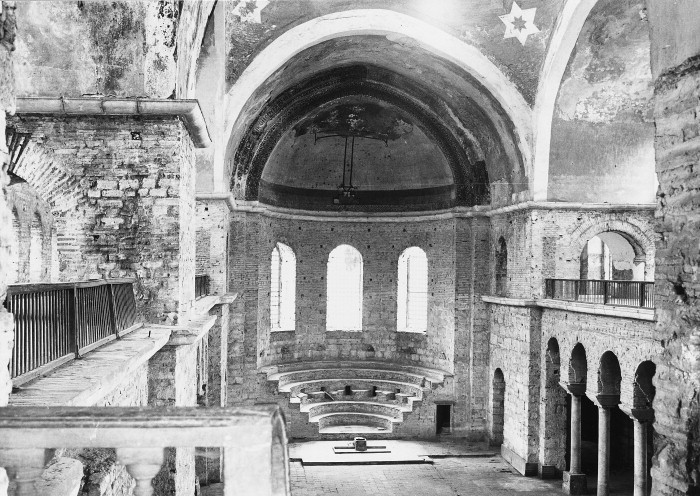
Below you can see the Patriarch blessing the congregation with a cross from an ambo.
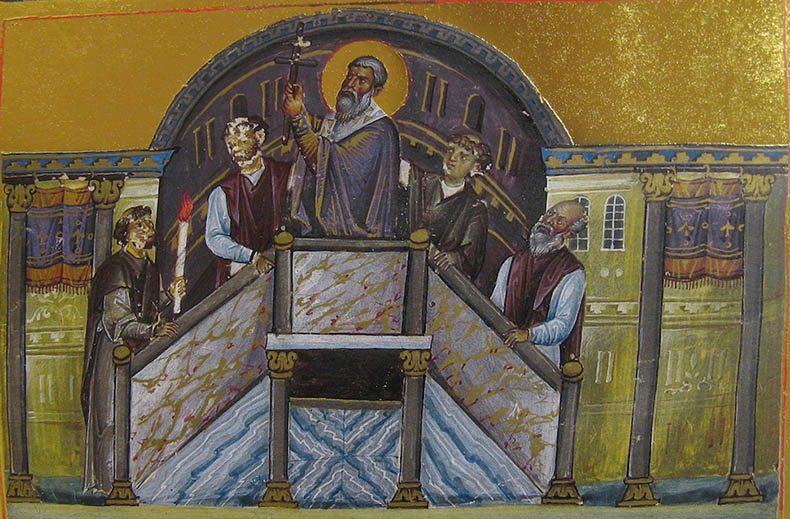
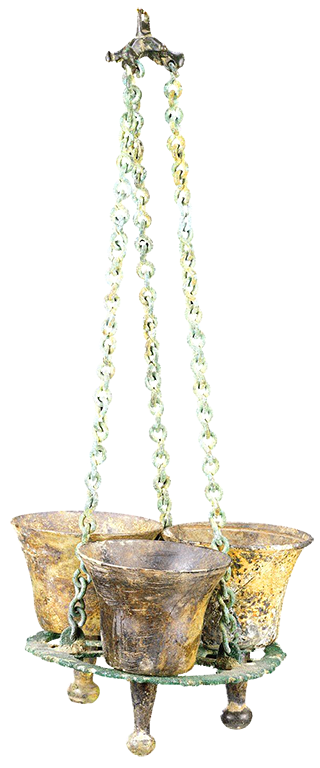
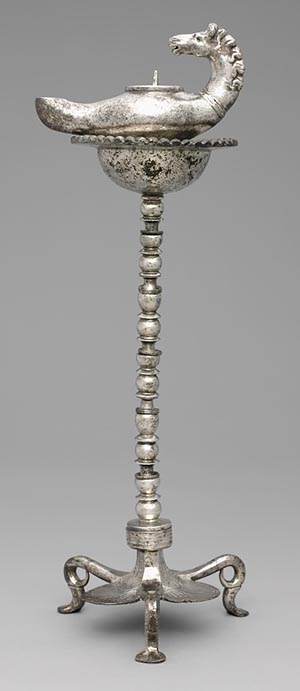
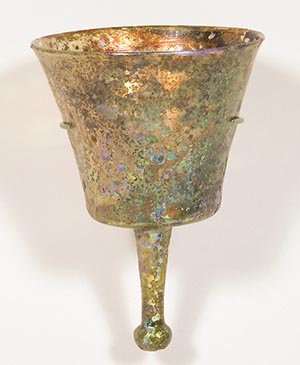
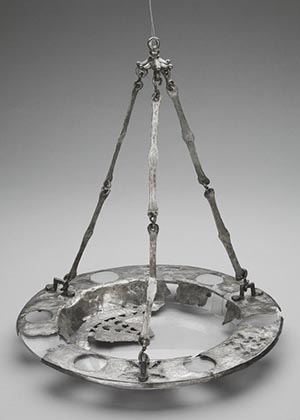
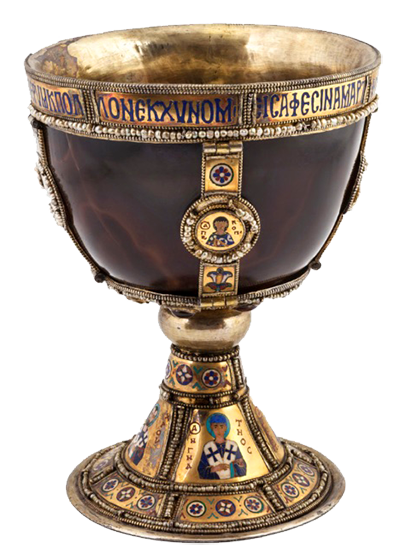
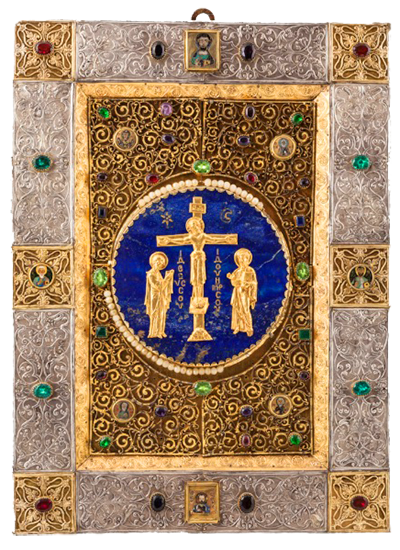
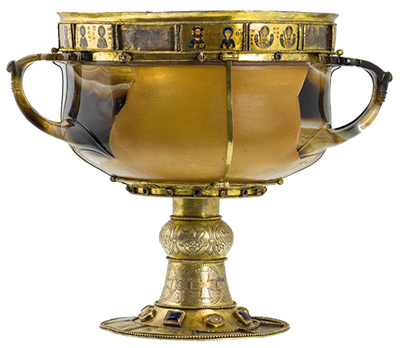
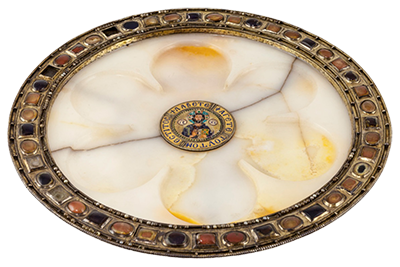
![]()
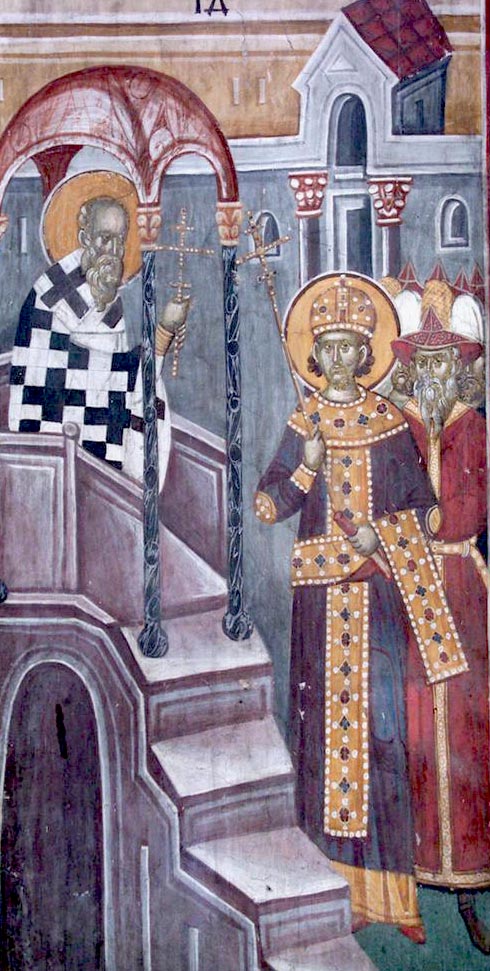











 The altar was covered by a great thick silk cloth that was heavily embroidered in silk, gold and silver thread. The cover was sewn with jewels, pearls and golden enamels. The cover folded down over all four sides of the altar and was fastened along its edges. Many people might have assumed this cover was made of gold. During services this was covered in a while veil. On the left is an example of a Russian silk sewn with pearls to show the richness of this kind of work. All of this was lost in 1204, restored in some form after 1261 and finally destroyed and looted forever in 1453. Add to this all of the silver polycandelon hanging from the vaults and dome of the church.
The altar was covered by a great thick silk cloth that was heavily embroidered in silk, gold and silver thread. The cover was sewn with jewels, pearls and golden enamels. The cover folded down over all four sides of the altar and was fastened along its edges. Many people might have assumed this cover was made of gold. During services this was covered in a while veil. On the left is an example of a Russian silk sewn with pearls to show the richness of this kind of work. All of this was lost in 1204, restored in some form after 1261 and finally destroyed and looted forever in 1453. Add to this all of the silver polycandelon hanging from the vaults and dome of the church. The altar of Hagia Sophia was considered by some to be the most beautiful ornament and the primary treasure of the church. It was covered by a silver, four columned, ciborium with a lofty vault. At top of the ciborium was a golden orb surmounted by a jeweled cross. The anonymous chronicle of Novgorod says the altar had 40 precious chalices on it that were looted by the crusaders. You can see one on the right. All of these chalices originally had covers. At least one of the looted chalices in St. Mark's still has its cover. (We know that emperors brought these chalices to Hagia Sophia one-by-one in procession. Walking behind him, a retainer carried the chalice and top for the emperor, and would hand the cup to him which the emperor then placed on the altar. Next they did the same with the top. Every chalice was honored in the same way). There was a little step for the emperor to stand on at the altar.
The altar of Hagia Sophia was considered by some to be the most beautiful ornament and the primary treasure of the church. It was covered by a silver, four columned, ciborium with a lofty vault. At top of the ciborium was a golden orb surmounted by a jeweled cross. The anonymous chronicle of Novgorod says the altar had 40 precious chalices on it that were looted by the crusaders. You can see one on the right. All of these chalices originally had covers. At least one of the looted chalices in St. Mark's still has its cover. (We know that emperors brought these chalices to Hagia Sophia one-by-one in procession. Walking behind him, a retainer carried the chalice and top for the emperor, and would hand the cup to him which the emperor then placed on the altar. Next they did the same with the top. Every chalice was honored in the same way). There was a little step for the emperor to stand on at the altar. 






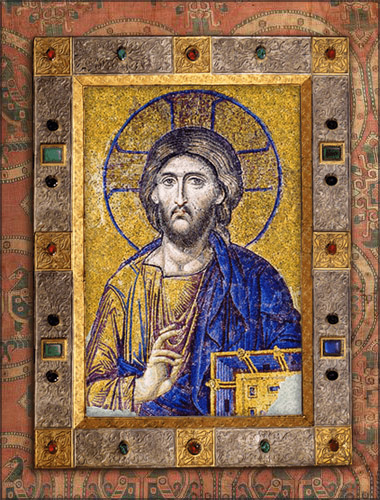

 click here for icons of christ
click here for icons of christ click here for icons of the theotokos
click here for icons of the theotokos click here for icons of angels
click here for icons of angels click here for icons of saints
click here for icons of saints








